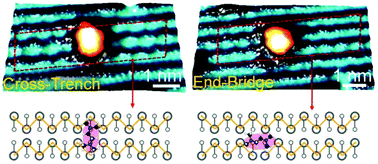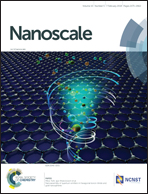How a tertiary diamine molecule chelates the silicon dimers of the Si(001) surface: a real-time scanning tunneling microscopy study†
Abstract
The patterning of silicon surfaces by organic molecules emerges as an original way to fabricate innovative nanoelectronic devices. In this regard, we have studied how a diamine, N,N,N′,N′-tetramethylethylenediamine (TMEDA, (CH3)2N–[CH2]2–N(CH3)2), chelates the silicon dimers of the Si(001)-2 × 1 surface. Starting from very low coverage to surface saturation (at 300 K), we used real-time scanning tunneling microscopy (STM) in a scanning-while-dosing approach. The images show that the molecules can adopt two bonding configurations: the cross-trench (CT) configuration by bridging two adjacent dimer rows, and the end-bridge (EB) configuration by chelating two adjacent dimers in the same row. However, while CT dominates over EB at low coverage, the percentage of EB adducts steadily increases, until it becomes largely dominant at high molecular coverage. Above a critical coverage θmol of ∼0.13 monolayer (ML), a sudden change in the molecular imprints is seen, likely due to a change in the tunneling conditions. The EB stapling of two adjacent dimers in a row via a dual-dative bond (as shown by XPS) is achieved efficiently by the TMEDA molecule with a very high chemical selectivity. The EB is a unique configuration in amine adsorption chemistry, as it leads to the formation of a pair of first-neighbor, doubly-occupied dangling bonds. Further reactivity of the EB site with other molecules remains to be explored, and possible reaction schemes are envisaged.



 Please wait while we load your content...
Please wait while we load your content...